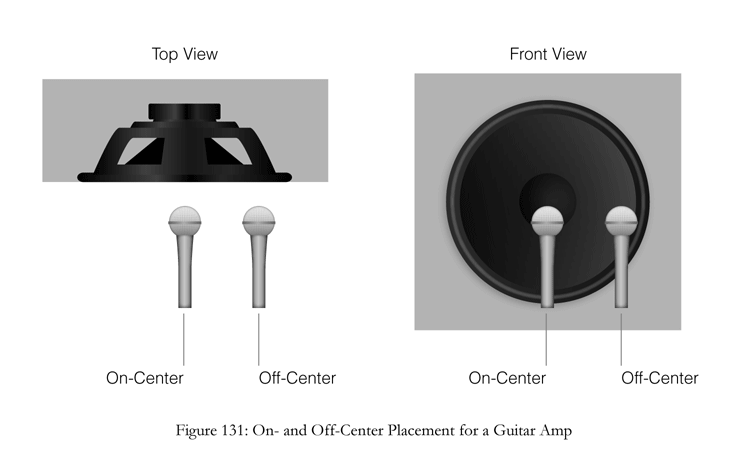When miking a guitar amplifier, the most common mic choices are a moving-coil dynamic or a wide-diaphragm condenser in a cardioid or hyper-cardioid pickup pattern. The Shure SM-57 has long been a standby as a workhorse dynamic mic and is a popular choice for close miking guitar amps. When using a condenser mic in a close placement, it’s advisable to check the SPL (sound pressure level) rating of the mic to make sure that it can handle the volume that is coming out of the amp.
Close miking an amplifier can be done on- or off-center to the speaker (see Fig. 131), meaning that it can be directed either at the center or the cone of the speaker. Miking the center will give a brighter tone, with the tone becoming more mellow as the mic is moved towards the edge of the speaker.
Placing a mic inside the back of the speaker cabinet provides thick, full tone from some amplifiers. Note that this placement will be 180˚ out-of-phase with mics placed on the front of the amp, so if they are being blended together, the phase will need to be reversed on this signal.
Placing mics at a distance of a few feet from the amp can also create a big sound, although the tone will be heavily affected by the room this is done in.
Recording the output of the guitar directly is also an option but has its own set of considerations. For clean, jazzy styles of music, the direct signal can be recorded by running the output of the guitar into a DI box. An overdriven electric guitar, however, creates some harsh sounding harmonics, which are smoothed out by the amplifier’s deliberately unresponsive speakers. For this reason, it is usually best to use an amp or speaker emulator when direct recording for rock, blues, and other gritty styles of music. Amp and speaker emulators can be found as standalone units or in software.
There are two main benefits of recording electric guitar in this manner. First, setup is more convenient and problems of signal bleed are reduced or eliminated when recording multiple instruments in the same room. The second benefit is that amp emulators offer the tone of a wide range of amplifiers, adding tonal versatility at a relatively low cost.
